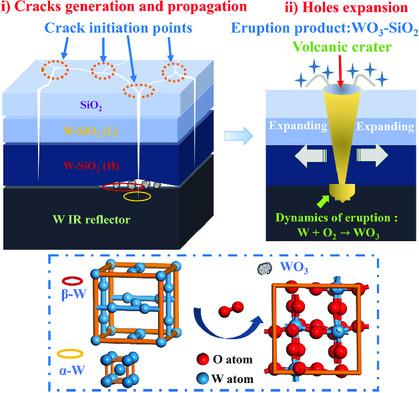Our official English website, www.x-mol.net, welcomes your feedback! (Note: you will need to create a separate account there.)
Stress‐Induced Failure Study on a High‐Temperature Air‐Stable Solar‐Selective Absorber Based on W–SiO2 Ceramic Composite
Solar RRL ( IF 7.9 ) Pub Date : 2020-09-04 , DOI: 10.1002/solr.202000336 Jiale Yang 1 , Honglie Shen 1, 2 , Zhiyan Yang 1 , Yuxin Zuo 1, 3 , Yang Zong 1 , Xiaomin Huo 1 , Yufang Li 1, 2
Solar RRL ( IF 7.9 ) Pub Date : 2020-09-04 , DOI: 10.1002/solr.202000336 Jiale Yang 1 , Honglie Shen 1, 2 , Zhiyan Yang 1 , Yuxin Zuo 1, 3 , Yang Zong 1 , Xiaomin Huo 1 , Yufang Li 1, 2
Affiliation

|
A stress‐induced failure study on a high‐temperature air‐stable ceramic composite solar selective absorber (SSA) based on a W–SiO2 system is reported. The as‐prepared SSA exhibits excellent spectral and structural stability after annealing in air at 500 °C for 36 h, proving its thermal stability against air corrosion. However, once the temperature is elevated to 600 °C, optical performance degradation and coating cracking happens. The X‐ray diffraction (XRD) patterns reveal that an O‐induced phase transition process from α‐W to β‐W occurs at the interface between the W IR reflector and W–SiO2 layer during deposition. The phase transition induces immense internal stress, which becomes the incentive of crack generation. Further increasing the annealing temperature, drastic structural changes of oxidized W become the driving force for crack propagation and hole expansion, leading to a failure analogous to a volcanic eruption. To improve the temperature limit of coating, a Ni–SiO2 stress buffer layer is introduced and successfully reduces the internal stress through Ni atom substitution for W atoms. Therefore, the optimized SSA keeps stable at 600 °C and the cracking temperature increases to 650 °C. These results suggest that the W–SiO2‐based SSA is a good candidate for air‐stable high‐temperature solar thermal conversion.
中文翻译:

基于W–SiO2陶瓷复合材料的高温空气稳定型太阳能选择性吸收剂的应力诱导失效研究
报道了基于W–SiO 2系统的高温空气稳定陶瓷复合太阳能选择性吸收器(SSA)的应力诱发失效研究。所制备的SSA在空气中在500°C下退火36小时后,具有出色的光谱和结构稳定性,证明了其对空气腐蚀的热稳定性。但是,一旦温度升高到600°C,光学性能就会下降,涂层会破裂。X射线衍射(XRD)图表明,在W IR反射镜和W–SiO 2之间的界面处发生了O诱导的从α-W到β-W的相变过程。沉积过程中的涂层。相变引起巨大的内应力,这成为裂纹产生的诱因。进一步提高退火温度,氧化的钨的剧烈结构变化成为裂纹扩展和孔扩展的驱动力,从而导致类似于火山喷发的破坏。为了提高涂层的温度极限,引入了Ni-SiO 2应力缓冲层,并通过用Ni原子代替W原子成功地降低了内部应力。因此,优化的SSA在600°C时保持稳定,裂化温度升至650°C。这些结果表明,基于W–SiO 2的SSA是空气稳定的高温太阳热转化的理想选择。
更新日期:2020-11-06
中文翻译:

基于W–SiO2陶瓷复合材料的高温空气稳定型太阳能选择性吸收剂的应力诱导失效研究
报道了基于W–SiO 2系统的高温空气稳定陶瓷复合太阳能选择性吸收器(SSA)的应力诱发失效研究。所制备的SSA在空气中在500°C下退火36小时后,具有出色的光谱和结构稳定性,证明了其对空气腐蚀的热稳定性。但是,一旦温度升高到600°C,光学性能就会下降,涂层会破裂。X射线衍射(XRD)图表明,在W IR反射镜和W–SiO 2之间的界面处发生了O诱导的从α-W到β-W的相变过程。沉积过程中的涂层。相变引起巨大的内应力,这成为裂纹产生的诱因。进一步提高退火温度,氧化的钨的剧烈结构变化成为裂纹扩展和孔扩展的驱动力,从而导致类似于火山喷发的破坏。为了提高涂层的温度极限,引入了Ni-SiO 2应力缓冲层,并通过用Ni原子代替W原子成功地降低了内部应力。因此,优化的SSA在600°C时保持稳定,裂化温度升至650°C。这些结果表明,基于W–SiO 2的SSA是空气稳定的高温太阳热转化的理想选择。



























 京公网安备 11010802027423号
京公网安备 11010802027423号